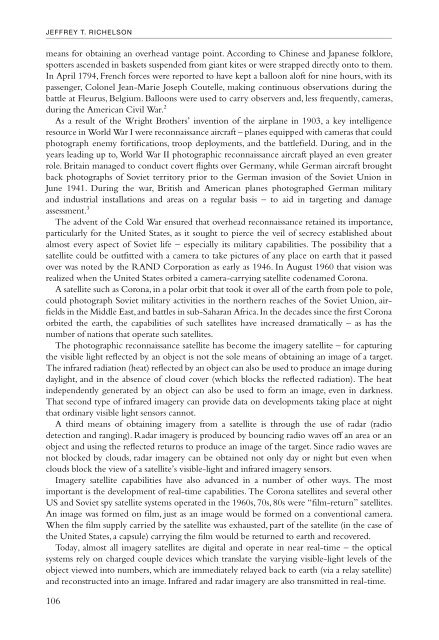Handbook of intelligence studies / edited by
Handbook of intelligence studies / edited by
Handbook of intelligence studies / edited by
You also want an ePaper? Increase the reach of your titles
YUMPU automatically turns print PDFs into web optimized ePapers that Google loves.
JEFFREY T. RICHELSON<br />
means for obtaining an overhead vantage point. According to Chinese and Japanese folklore,<br />
spotters ascended in baskets suspended from giant kites or were strapped directly onto to them.<br />
In April 1794, French forces were reported to have kept a balloon al<strong>of</strong>t for nine hours, with its<br />
passenger, Colonel Jean-Marie Joseph Coutelle, making continuous observations during the<br />
battle at Fleurus, Belgium. Balloons were used to carry observers and, less frequently, cameras,<br />
during the American Civil War. 2<br />
As a result <strong>of</strong> the Wright Brothers’ invention <strong>of</strong> the airplane in 1903, a key <strong>intelligence</strong><br />
resource in World War I were reconnaissance aircraft – planes equipped with cameras that could<br />
photograph enemy fortifications, troop deployments, and the battlefield. During, and in the<br />
years leading up to, World War II photographic reconnaissance aircraft played an even greater<br />
role. Britain managed to conduct covert flights over Germany, while German aircraft brought<br />
back photographs <strong>of</strong> Soviet territory prior to the German invasion <strong>of</strong> the Soviet Union in<br />
June 1941. During the war, British and American planes photographed German military<br />
and industrial installations and areas on a regular basis – to aid in targeting and damage<br />
assessment. 3<br />
The advent <strong>of</strong> the Cold War ensured that overhead reconnaissance retained its importance,<br />
particularly for the United States, as it sought to pierce the veil <strong>of</strong> secrecy established about<br />
almost every aspect <strong>of</strong> Soviet life – especially its military capabilities. The possibility that a<br />
satellite could be outfitted with a camera to take pictures <strong>of</strong> any place on earth that it passed<br />
over was noted <strong>by</strong> the RAND Corporation as early as 1946. In August 1960 that vision was<br />
realized when the United States orbited a camera-carrying satellite codenamed Corona.<br />
A satellite such as Corona, in a polar orbit that took it over all <strong>of</strong> the earth from pole to pole,<br />
could photograph Soviet military activities in the northern reaches <strong>of</strong> the Soviet Union, airfields<br />
in the Middle East, and battles in sub-Saharan Africa. In the decades since the first Corona<br />
orbited the earth, the capabilities <strong>of</strong> such satellites have increased dramatically – as has the<br />
number <strong>of</strong> nations that operate such satellites.<br />
The photographic reconnaissance satellite has become the imagery satellite – for capturing<br />
the visible light reflected <strong>by</strong> an object is not the sole means <strong>of</strong> obtaining an image <strong>of</strong> a target.<br />
The infrared radiation (heat) reflected <strong>by</strong> an object can also be used to produce an image during<br />
daylight, and in the absence <strong>of</strong> cloud cover (which blocks the reflected radiation). The heat<br />
independently generated <strong>by</strong> an object can also be used to form an image, even in darkness.<br />
That second type <strong>of</strong> infrared imagery can provide data on developments taking place at night<br />
that ordinary visible light sensors cannot.<br />
A third means <strong>of</strong> obtaining imagery from a satellite is through the use <strong>of</strong> radar (radio<br />
detection and ranging). Radar imagery is produced <strong>by</strong> bouncing radio waves <strong>of</strong>f an area or an<br />
object and using the reflected returns to produce an image <strong>of</strong> the target. Since radio waves are<br />
not blocked <strong>by</strong> clouds, radar imagery can be obtained not only day or night but even when<br />
clouds block the view <strong>of</strong> a satellite’s visible-light and infrared imagery sensors.<br />
Imagery satellite capabilities have also advanced in a number <strong>of</strong> other ways. The most<br />
important is the development <strong>of</strong> real-time capabilities. The Corona satellites and several other<br />
US and Soviet spy satellite systems operated in the 1960s, 70s, 80s were “film-return” satellites.<br />
An image was formed on film, just as an image would be formed on a conventional camera.<br />
When the film supply carried <strong>by</strong> the satellite was exhausted, part <strong>of</strong> the satellite (in the case <strong>of</strong><br />
the United States, a capsule) carrying the film would be returned to earth and recovered.<br />
Today, almost all imagery satellites are digital and operate in near real-time – the optical<br />
systems rely on charged couple devices which translate the varying visible-light levels <strong>of</strong> the<br />
object viewed into numbers, which are immediately relayed back to earth (via a relay satellite)<br />
and reconstructed into an image. Infrared and radar imagery are also transmitted in real-time.<br />
106
















